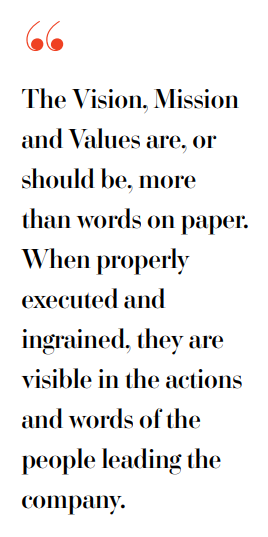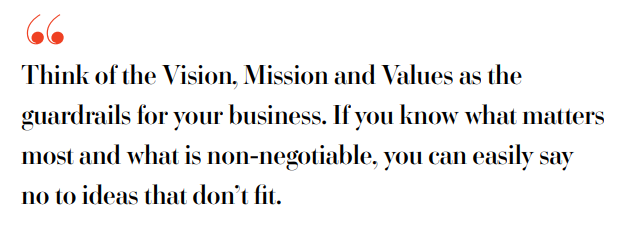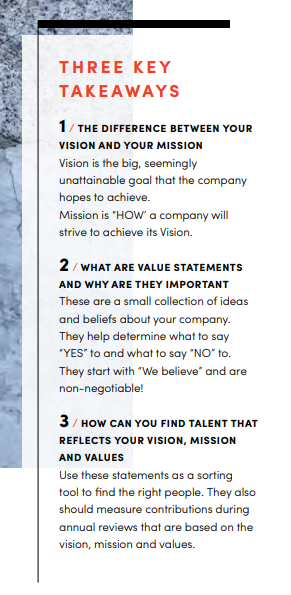Make sure they reflect your company and your culture
Who are you?
It sounds like a silly question. Or the beginning of an awkward introduction.
When I ask the question to a group of executives, I’m asking about who they are as a company.
What do you stand for?
How do you act?
What expectations do you have for each other and the team around you?

But, the answers I get are—normally—about the products, the opportunity or the way you want people in the field to think of the company.
Recently, I’ve worked with a few companies who like to talk about their culture and how special it is. They are convinced that folks in the field love “The Culture” of the company. “They believe in us.” “They trust us.”
But, after conducting interviews with some of the folks in the field, it becomes clear that the feeling of the culture is superficial. Maybe even wishful. They seem to play nice together but, often, there is frustration. They don’t understand why things are the way they are. They don’t believe their concerns are being heard or addressed. They seem to really like the people inside the company but want more from them.
And, inside the company, they don’t understand why the field is the way they are. “They keep asking for more.” They “don’t understand how hard it is” to change the things they keep wanting addressed. “They always expect more from us.”
Sound familiar?
Yet, the corporate executives are still bragging about how great their culture is.
Something doesn’t make sense. There is a disconnect. A big one.
This disconnect starts inside the company. The company owns it. The leadership on the corporate team created it. Or—at the very least—allowed it to occur and hasn’t done enough to correct it.
I believe strongly in the power of a company’s Vision, Mission and Values to begin the alignment process and get everyone working together.
The Vision, Mission and Values are, or should be, more than words on paper. When properly executed and ingrained, they are visible in the actions and words of the people leading the company.

Unfortunately, many leaders hand off the process of developing the Vision, Mission and Values to the marketing team. At some point, they get written in a company handbook and put in big bold letters on the walls in the office—as if to say, “See, we have our Vision, Mission and Values….”
Ugh!
First, let’s establish what these terms mean and how they work together to make a company stand out from the crowd. Although there are a few ways of thinking of the definitions, I’m a simple guy, and we use the following to help guide the discussions with executive teams.
Vision—the big, seemingly unattainable goal that the company hopes to achieve. It is a statement with power. It is aspirational—a cause worth fighting for.
Mission—to oversimplify it, think of it as “HOW’ a company will strive to achieve its Vision.
For example, Tesla’s Vision—To accelerate the world’s transition to sustainable energy.
Tesla’s Mission—To create the most compelling car company of the 21st century by driving the world’s transition to electric vehicles.
The Vision statement says nothing about cars or batteries. It is the impact they hope to make on a grander scale. The Mission brings those into play as a way to accomplish the vision.
Nike, another global giant, takes the same approach.
Nike’s Vision—Bring inspiration and innovation to every athlete* in the world.
*if you have a body, you are an athlete.
Nike’s Mission—Create groundbreaking sports innovations, make our products sustainably, build a creative and diverse global team and make a positive impact in communities where we live and work.
The Vision is not about shoes, clothing or basketballs. It’s bigger than that.
It’s not about Michael Jordan. It’s about YOU.
I could go on and on with fantastic examples of Vision and Mission statements, but you get the idea.
Too often, executive teams intertwine the two statements and, instead of creating clarity, they cause confusion. Keep them clear, separate and precise.
Lastly, we need to get our Values statements defined. These are a small collection of non-negotiable ideas and beliefs to express what is valued and how the company treats people that come into contact with it. These are super-important. They help determine what opportunities to say “YES” to and, just as importantly, what to say “NO” to.
A very common way to view them is a collection of statements that begin with “We believe….”.

They should say the Values you believe in so that you can do the things in the Mission while striving toward the Vision.
I encourage teams to determine about five statements that, if read together, someone would clearly know what matters to you and your company. It’s easy to come up with a dozen, it’s difficult to narrow down your focus to five. But, that clarity matters.
I also encourage teams to avoid things that should be table stakes. Words like “integrity” and “honesty” come to mind. As a human, shouldn’t those be expected? Let’s just all commit to do our best to not be working with or hiring folks who are lacking in those areas. Agree? If we mess up and they make it into the company, fix it. FAST!
Caution — if you’re willing to accept a deviation from the Values you publish, you will be causing massive damage to your culture. As we said, these are NON-NEGOTIABLE. These explain who you are.
Recently, I worked with an executive team to evaluate their existing and proposed Vision, Mission and Values. Once we got past the eye-rolls from the team that clearly said “Here we go again,” the team became focused on the real meaning of the words. It didn’t happen immediately and we didn’t rush the process. But, over the course of six to eight weeks, we spent about 15-20 hours working together to form a few important sentences.
They toiled over EVERY word and phrase. Then, we all took time to digest them before we debated more. If we had completed the process in one meeting, I feel very confident in saying there would have been a lot of tweaking after the fact. And there would have been minimal buy-in from the team. In the end, every sentence needed to mean something and be worth fighting for. After all, the executives needed to be able to stand in front of their teams and tell them they believed in the statements and would be reinforcing the Vision, Mission and Values on a daily basis. They needed to own the words and defend them.

They focused on a few key beliefs that felt important to who they are. Topics like “family,” “wellness,” “servant leadership,” “philanthropy,” “empowerment” and “personal growth” kept popping up as key feelings that they felt were non-negotiable.
There was healthy debate and disagreement that led to greater understanding of themselves and each other. Frankly, it was amazing. After crafting the words and sentences together, their end result was absolutely the best representation I had ever seen or heard of that company.
Over the next four weeks, they went on to share and discuss all of this with their entire corporate teams. Small groups who could gain a clear understanding of the process and why the words came to life. It was a chance to gain buy-in and set expectations at every level of the company. Then, starting with top leaders, it was all rolled out to the field.
But, why does this matter?
Think of the Vision, Mission and Values as the guardrails for your business. If you know what matters most and what is non-negotiable, you can easily say no to ideas that don’t fit. More importantly, you can say yes and run faster inside the lane you’ve created for yourself when everyone knows what matters most.
It’s not all rosy and happy. It takes work and difficult decisions.
In order for this all to come to life and have meaning, leadership has to hire people based on the fact that they will fit into the definitions created. Make it clear of the expectation. Your HR team has to use the statements as a sorting tool to find the right people for your company. They also should measure contributions during annual reviews that are based on the vision, mission and values. Some people will love it. Others won’t. And, that’s ok. You can’t appeal to everyone.

In fact, once you define and live the beliefs, you will find prospects and folks in the field who gravitate to you as well. That’s what we want. People who know and like us for who we are. We cannot morph to be something for one group and something different for another. If you are trying to appeal to everyone, you will appeal to no one. Let’s just find the folks who want to be with us because of who we are.
On the flipside: You must be willing to FIRE when someone clearly doesn’t fit or believe in the company and its values. I’ve seen it too often where one person is kept on the team because they are a mid- or even high-level contributor but does not fit into the values the company espouses. This can be devastating to the rest of the team. If you—the executive team—allow this to occur, your credibility is dissolved quickly. But, if you are willing to take the steps to correct it, you can recover. We all make mistakes. How we handle them is everything. Sometimes, addition by subtraction is the right answer.
If you have a great Vision, Mission and Values and live them every day—Congratulations! There are many who do. When I walk into some companies around our industry, it doesn’t take long to “feel” whether it is real or not.
However, if you are struggling to build the culture you’re looking for, I would encourage you to truly evaluate whether or not you are living up to the words on paper you created when you started the company. It’s ok to make a change. What’s not ok is to let it ride and expect things to change on their own.

Paul Adams has been involved in the direct selling channel for more than 30 years. Over the decades, he has worked with hundreds of companies and been a trusted advisor in boardrooms with countless executive teams. From corporate giants to pre-startup, Paul has helped companies invent, reinvent and solidify their messaging, strategy and execution.
From the May 2022 issue of Direct Selling News magazine.


